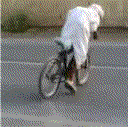Some long turns -- generally 180 degrees or more -- give you a choice of lines. A good example is Courage on the VIR South Course, which connects the front straight and the infield straight leading to the Spiral.
With these corners, you can take it as a single Type I. You can turn in once, take a late apex, and exit it onto the next straight just like a textbook Type I.
You could also divide it into two corners, a Type II coming off the front straight and a Type I exiting onto the infield straight.


Which one do you use?
Which one works best for you depends on a lot of factors. Does your bike accelerate, brake, and turn rapidly, or do you have to take longer braking, have low power for acceleration, and take longer to turn? In the former case, you can dive into the Type II, snap it over, and launch out of the Type I. In the latter case, the tight turn in the middle takes too long and loses too much speed to be worth it, so a single long Type I will give you better exit speed.
As a general rule of thumb, if you can take it as a single corner, try that way first. It's not easy, because you have to turn very late and turn your head way around to look for the apex. In some ways it's more difficult that way, because hitting the apex so far around the corner is mentally hard to do -- it's easy to be a Sleazeball -- but it is the better initial line.
Are there exceptions? Sure there are. No matter what type of bike you have, if the corner is tight enough, you will have to slow down to a crawl in the middle of the corner. In that case, you'd just as well slow enough to take it as a Type II/I Combo, since you have to brake a lot and accelerate from a minimal speed.
Skills you have to master first
Taking a corner as a double II/I requires some technical bike-handling skills that are not easy to put together.
Look at the line above, and you'll see that there's a lot happening very quickly. You get on the brakes, turn in, get back on the gas, back on the brakes, flick the bike over very rapidly, and get back hard on the gas again. Mess up any one of those, and if you're not accustomed to how rapidly things are happening, you can be in trouble very quickly indeed. Also, in the case of Courage at VIR, you no longer have the option of the "escape road" if you miss your braking.
Like everything else on the track, slow down when you're working on this. Get the line and technique right, and as you get comfortable with it you can attack the transitions harder.
Using this on the street
Any of you who've seen me ride twisties in the mountains will immediate recognize one of the ways I go fast in the very tight stuff -- for me, every switchback is a II/I combo. It's very hard work, gets some very funny looks, but it is fast.
You have to be careful, however, not to over-ride your sight lines. If you can't clearly see the point where you'd transition between the Type II and the Type I, you can't safely take it that way. It works best in switchbacks, where you can see not only the whole corner but the straight following it too.
From TrackDoD Novice Group Orientation



No comments:
Post a Comment